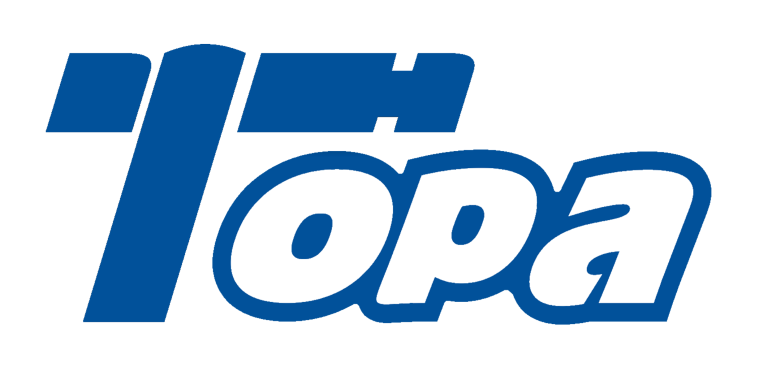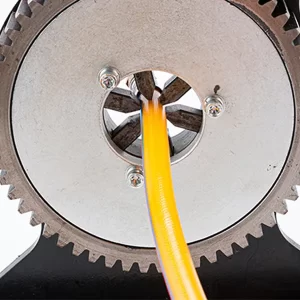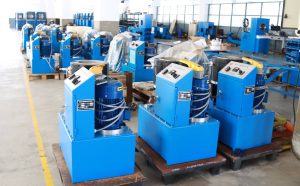When it comes to operating a hydraulic hose crimper, proper training is crucial for ensuring the safety and efficiency of your operations. Hydraulic hose crimpers are powerful tools that are used to attach hydraulic fittings to hoses, and using them improperly can lead to accidents, equipment damage, and costly downtime. In this article, we will dive into the necessary training required to operate a hydraulic hose crimper effectively and safely.
1. What Basic Skills Are Required for Operating a Hydraulic Hose Crimper?
Operating a hydraulic hose crimper requires a solid foundation of skills and knowledge, primarily in handling hydraulic systems and tools. First and foremost, it’s essential to have an understanding of the basic principles of hydraulics, such as how fluid pressure works and how it impacts the operation of the crimper. Without this understanding, the operator may struggle to properly use the equipment and could potentially cause damage to the system.
Secondly, familiarity with the specific tools and equipment involved is necessary. Hydraulic hose crimpers are highly specialized machines, and understanding their components—from the crimping die to the pressure settings—is critical for success. Not only must operators know how to handle the crimper itself, but they also need to know how to correctly install and remove crimping dies, adjust the pressure settings, and troubleshoot issues that may arise.
Lastly, safety protocols are a key aspect of basic training. Operators must be aware of the potential hazards associated with hydraulic systems and understand how to protect themselves and their colleagues. This includes wearing the correct personal protective equipment (PPE), such as gloves, goggles, and hearing protection, as well as following safe operating procedures to minimize risks.
Table: Basic Skills for Operating a Hydraulic Hose Crimper
| Skill Required | Explanation |
|---|---|
| Understanding of Hydraulics | Basic knowledge of how hydraulic systems work |
| Familiarity with Tools | Understanding the components of a hose crimper |
| Safety Protocols | Awareness of safety procedures and PPE usage |
2. What Knowledge Should You Have About Hydraulic Hose and Fittings?
To effectively operate a hydraulic hose crimper, operators must have an in-depth knowledge of hydraulic hoses and fittings. This knowledge is essential because selecting the right hose and fitting for the job directly impacts the crimping process.
First, it’s vital to understand the different types of hydraulic hoses and their applications. There are various hose types designed for different pressures, temperatures, and fluid types. The operator must know how to select the appropriate hose based on the requirements of the hydraulic system they are working with.
Next, understanding the various types of hydraulic fittings is also crucial. Fittings come in different shapes, sizes, and materials, and each type is designed for specific applications. Operators must know how to match the correct fitting with the hose to ensure a secure and leak-free connection. Improper fitting selection can lead to a weak connection, which can be dangerous and costly.
Lastly, it’s important to know the hose and fitting specifications, such as pressure ratings, bend radii, and material compatibility. These specifications help ensure that the crimped connection can withstand the required pressures and environmental conditions without failure.
Table: Hydraulic Hose and Fitting Knowledge
| Component | Importance | Examples |
|---|---|---|
| Hydraulic Hoses | Choose hoses based on system requirements | High-pressure, oil-resistant hoses |
| Hydraulic Fittings | Correct fitting selection for secure connections | O-ring, barb, compression fittings |
| Hose Specifications | Understanding pressure, bend radius, and material compatibility | Pressure ratings, temperature resistance |
3. How Does Crimping Force and Pressure Affect Hose Performance?
Understanding the relationship between crimping force and pressure is fundamental to operating a hydraulic hose crimper. The crimping force refers to the amount of pressure applied to the fitting and hose to form a secure connection. The right crimping force is critical to ensuring the hose performs well under pressure.
First, it’s important to know that insufficient crimping force can lead to a weak connection. If the crimp is too loose, it may not properly hold the fitting, resulting in leaks or even system failure. On the other hand, excessive crimping force can damage the hose and fitting, reducing the integrity of the connection and shortening the life of the hose.
The crimping pressure must match the specifications of the hose and fitting. Each hose and fitting type has its own pressure rating, and exceeding this pressure can cause severe damage. Proper training ensures that operators understand how to adjust the crimping pressure based on the materials and pressure ratings of the hoses and fittings they are working with.
Table: Impact of Crimping Force on Hose Performance
| Crimping Force (Tons) | Effect on Hose Performance | Potential Issue |
|---|---|---|
| Low Force | Inadequate connection, leaks | Weak connection, hose failure |
| Correct Force | Secure and leak-proof connection | Optimal hose performance |
| High Force | Damage to hose and fitting | Hose rupture, fitting damage |
4. How Do You Read and Understand Hydraulic Hose Crimper Manuals?
The hydraulic hose crimper manual is a critical resource for operators. It provides essential information on the operation, maintenance, and safety procedures for the crimper. But here’s the kicker—many operators overlook the manual or fail to interpret the information correctly, which can lead to misuse or accidents.
The manual typically contains detailed instructions on how to set up and operate the crimper, including how to install and adjust crimping dies, set pressure limits, and maintain the tool. It’s important to read through the manual thoroughly and understand the specifications provided by the manufacturer. This ensures that the operator can use the crimper in accordance with the manufacturer’s guidelines, reducing the risk of errors or damage.
Additionally, most manuals include troubleshooting sections that provide solutions to common issues, such as uneven crimps or malfunctioning equipment. Being able to read and understand the manual is vital for ensuring the tool’s longevity and performance.
Table: Key Components of Hydraulic Hose Crimper Manuals
| Section | Description |
|---|---|
| Setup Instructions | How to prepare and adjust the crimper for use |
| Pressure Settings | Information on pressure settings for different hoses |
| Maintenance Guidelines | Instructions for routine maintenance and repairs |
| Troubleshooting | Solutions to common issues during operation |
5. What Are the Key Safety Protocols to Follow When Using a Hydraulic Hose Crimper?
Safety is paramount when operating any heavy-duty machinery, including hydraulic hose crimpers. Proper training includes learning the safety protocols necessary to avoid accidents and injuries. The first step in safety training is learning how to properly use personal protective equipment (PPE).
Operators should wear gloves, safety goggles, and hearing protection when using the crimper. These PPE items help protect the operator from flying debris, pressure hazards, and loud noise. In addition to PPE, operators should always be aware of the crimper’s surroundings to prevent accidents caused by distractions or improper handling.
Training should also cover emergency procedures, such as how to shut down the equipment in case of malfunction. Understanding how to stop the crimper safely is critical to minimizing risk in an emergency situation.
Finally, operators must be trained in the proper maintenance of the crimper. Regular inspections and maintenance are essential for keeping the equipment in safe working condition. By following the manufacturer’s maintenance guidelines and addressing issues before they become problems, operators can ensure that the crimper functions safely over its lifespan.
Table: Essential PPE for Hydraulic Hose Crimper Operators
| PPE Item | Purpose |
|---|---|
| Gloves | Protects hands from cuts and pressure hazards |
| Safety Goggles | Shields eyes from debris and pressure accidents |
| Hearing Protection | Reduces exposure to high noise levels |
6. How Do You Perform Maintenance and Inspection of a Hydraulic Hose Crimper?
Routine maintenance is essential for ensuring the long-term functionality and safety of a hydraulic hose crimper. A well-maintained crimper is less likely to fail during operation, and it will continue to produce high-quality crimps that meet industry standards. Maintenance tasks include regular cleaning, checking for wear and tear, and replacing parts that show signs of damage.
First, operators should clean the crimper after each use to remove any debris or buildup that could impair its performance. The crimper’s moving parts, such as the crimping dies and pressure mechanisms, should be regularly lubricated to prevent friction and wear. Checking for loose bolts or worn-out seals is also important for maintaining the crimper’s integrity.
Training should cover how to inspect the crimper for signs of damage or wear. If parts like the crimping dies are worn down, they should be replaced promptly to avoid poor crimps. Regular calibration is also necessary to ensure the crimper is applying the correct amount of pressure to the hose.
Table: Maintenance Tasks for Hydraulic Hose Crimpers
| Maintenance Task | Frequency | Purpose |
|---|---|---|
| Cleaning the Crimper | After each use | Prevents buildup and maintains functionality |
| Lubrication of Moving Parts | Monthly | Reduces wear and friction |
| Die and Seal Inspection | Monthly | Ensures proper crimping and avoids damage |
| Calibration | Quarterly | Maintains pressure accuracy and performance |
7. What Are the Different Types of Hydraulic Hose Crimpers and How Do They Work?
Hydraulic hose crimpers come in various types, each suited for different applications and business needs. The two main categories are manual crimpers and powered crimpers, and each offers its own set of advantages and limitations.
Manual crimpers are ideal for smaller businesses or those that don’t require high-volume crimping. They are affordable, easy to operate, and portable, making them a popular choice for those working with small hoses or lower-pressure systems. However, manual crimpers may not be suitable for large-scale operations or heavy-duty applications.
On the other hand, powered crimpers are more efficient and capable of handling larger hoses and higher pressures. These crimpers use hydraulic or electric power to apply crimping force, reducing operator effort and increasing production speed. Powered crimpers are ideal for high-volume operations, but they come with a higher price tag and require more maintenance.
Understanding the differences between manual and powered crimpers is key to selecting the right tool for your business needs. Training should cover the specific features and capabilities of each crimper type to ensure operators can use them to their full potential.
Table: Manual vs. Powered Hydraulic Hose Crimpers
| Crimper Type | Advantages | Disadvantages |
|---|---|---|
| Manual | Cost-effective, portable, simple to use | Slower, labor-intensive, limited capacity |
| Powered | Faster, less effort, handles larger hoses | Higher cost, more maintenance required |
8. How Do You Ensure Accurate Crimping Every Time?
Accurate crimping is essential for ensuring the safety and reliability of the hydraulic system. But here’s the kicker—accuracy doesn’t just happen by chance. It requires precision, practice, and the right equipment settings. To achieve consistent and accurate crimps, operators must be trained on how to adjust the crimper to match the specific hose and fitting specifications.
The first step is understanding how to properly measure the hose and fitting to ensure they match. Many crimpers come with gauges or templates that help operators measure the crimp diameter and depth. Operators should also be trained to verify the crimping pressure and adjust it according to the manufacturer’s recommendations.
Regular calibration of the crimper is also critical for maintaining accuracy. Over time, the crimper’s pressure settings may drift, leading to inconsistent crimps. By performing routine checks and adjustments, operators can ensure the crimper is always applying the correct amount of force for a secure connection.
Table: Factors Affecting Crimp Accuracy
| Factor | Importance | Tips for Accuracy |
|---|---|---|
| Hose and Fitting Match | Ensures a proper connection | Measure carefully and use templates |
| Crimping Pressure | Ensures proper fitting attachment | Adjust according to manufacturer specs |
| Regular Calibration | Prevents pressure drift and inconsistent crimps | Perform routine checks and adjustments |
9. How Do You Troubleshoot Common Hydraulic Hose Crimper Issues?
Even the best crimpers can experience problems from time to time. Understanding how to troubleshoot common issues is a critical skill for operators. One of the most frequent issues is uneven crimps. This can be caused by incorrect pressure settings, misalignment of the dies, or worn-out parts. Operators should be trained to recognize these issues and take corrective action immediately.
Another common problem is crimper malfunction, such as failure to apply pressure or difficulty adjusting the dies. In such cases, operators should be familiar with the troubleshooting steps outlined in the crimper’s manual, such as resetting the pressure settings or inspecting the crimper for mechanical faults.
By learning how to identify and address these issues, operators can minimize downtime and keep the crimping process running smoothly.
Table: Common Hydraulic Hose Crimper Issues
| Issue | Possible Causes | Solutions |
|---|---|---|
| Uneven Crimps | Incorrect pressure, misalignment | Adjust pressure, check die alignment |
| Crimper Malfunction | Worn-out parts, mechanical failure | Inspect and replace parts, recalibrate |
10. What Role Does Experience Play in Operating a Hydraulic Hose Crimper?
Experience is a vital component of becoming proficient at operating a hydraulic hose crimper. While training provides the foundational knowledge, hands-on experience allows operators to develop the muscle memory and intuition needed to perform crimping tasks quickly and accurately. Experienced operators are better able to recognize potential problems before they arise, troubleshoot effectively, and adjust settings as needed for optimal results.
For instance, experienced operators can often identify slight imperfections in the crimp and make adjustments in real-time. Additionally, they may have a better understanding of how to handle various hose and fitting materials, ensuring that they can adapt to different jobs without requiring much supervision.
Table: Experience vs. Skill Level
| Experience Level | Skills Developed | Benefits |
|---|---|---|
| Beginner | Basic crimping skills, tool handling | Requires guidance, limited efficiency |
| Intermediate | Crimping precision, tool adjustments | Can work independently, moderate efficiency |
| Expert | Advanced troubleshooting, fast setup | High efficiency, minimal errors |
Conclusion
In conclusion, the training required to operate a hydraulic hose crimper is comprehensive and covers a wide range of skills, from understanding hydraulic systems to mastering crimping techniques and safety protocols. Operators must be knowledgeable about the different types of crimpers, hoses, and fittings to ensure that each crimp is accurate and secure. Proper training and hands-on experience play a crucial role in ensuring that the crimper operates safely and efficiently. By following the training guidelines outlined in this article, operators can confidently work with hydraulic hose crimpers, contributing to the success and safety of their businesses.
FAQ Section
Q1: What is hydraulic hose crimping?
A hydraulic hose crimping is the process of securely attaching hydraulic fittings to hoses by applying pressure to form a secure connection.
Q2: How does hydraulic hose crimping work?
The crimper applies hydraulic pressure to squeeze the fitting onto the hose, creating a tight seal that prevents leaks. Proper crimping ensures the hose can handle high-pressure conditions without failure.
Q3: What is the training process for hydraulic hose crimper operators?
The training process includes learning about hydraulic systems, safety procedures, crimping techniques, equipment maintenance, and troubleshooting. It also covers the correct use of manuals and understanding specifications for various hoses.
Q4: Why is safety important when operating a hydraulic hose crimper?
Safety is crucial to prevent injuries from improper handling, high-pressure systems, and tool malfunctions. Operators must use personal protective equipment (PPE) and adhere to safe operating procedures to avoid accidents.
Q5: How do you maintain a hydraulic hose crimper?
Regular maintenance includes cleaning, lubricating, and inspecting the crimper to ensure it functions correctly and lasts longer.




